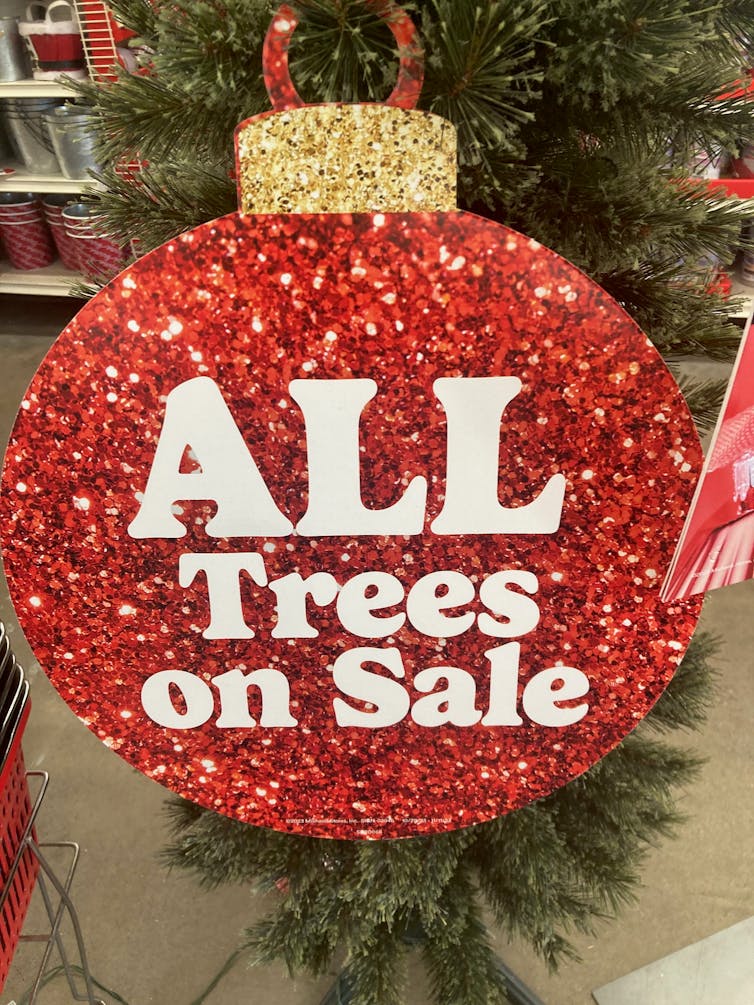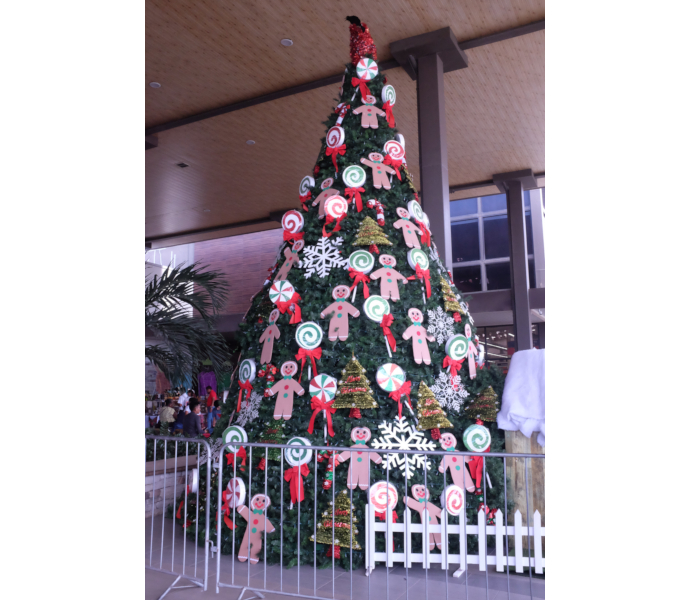The tree at the Boulevard shopping center in Penonome. The photographer, and the editor, Eric Jackson, confesses a certain bias here. At age 17 in northern Michigan he had a job harvesting Christmas trees. It was instructive, but awful.
Oh, Christmas tree: The economics of the US holiday tree industry
by Jay L. Zagorsky, Boston University and Patrick Abouchalache, Boston University
Christmas today is a big business, and one part of that is the multibillion-dollar business of selling Christmas trees. The U.S. Christmas tree industry is so large, it even has two dueling trade groups: one that supports natural trees and the other, artificial.
We are two business school professors whose students asked us to explain the economic impact of the winter holidays. In the holiday spirit of sharing, we’re giving you some facts to discuss while trimming your tree.
Where to buy a natural Christmas tree – or chop one down yourself
There are three different ways to get a natural Christmas tree.
First, you can go into a national forest and chop down your own. Relatively few Americans do this, even though a permit costs $10 or less, because government rules require that the tree you chop must be more than 200 feet from any road, campground or recreation area. Since dragging a tree destroys its branches and needles, the 200-foot rule means that large, heavy trees have to be carried a fair distance through often snowy woods.
Your second option is to buy or chop down a tree at a local Christmas tree farm. Christmas tree farms got a big promotional boost when Taylor Swift revealed she grew up on one, but she’s hardly alone: There are nearly 3,000 Christmas tree farms across the USA, according to the Department of Agriculture’s most recent figures. These farms sell around 12 million trees a year.
While being a Christmas tree farmer sounds idyllic, it isn’t very profitable, since Christmas trees take over a decade to grow large enough to sell. Long lead times combined with changing and unpredictable weather have pushed many of these farms out of business. Almost 500 US Christmas tree farms shuttered between 2014 and 2019, the USDA found.
The third way to buy a tree is from a local retailer that imports trees. In 2022, the United States imported almost 3 million natural Christmas trees, primarily from Canada. Imports have been growing steadily: In 2014, the United states imported only half as many trees.
Together, this means that in 2022, roughly 15 million locally grown or imported natural trees were sold in the country.
Some people like to buy their trees from a nonprofit, like the Boy Scouts. These fundraisers are also supplied from local Christmas tree farms or imports.
An artificial tree’s journey from China to your living room
Artificial trees are popular with people who don’t like the mess and fuss of natural trees. Replica trees primarily come from China, and most are made in the Chinese city of Yiwu. The United States imported over 20 million artificial trees in 2022 alone.
And they’re becoming increasingly common. In 2014, the United States imported 11 million artificial trees and sold almost 22 million natural trees. This means that back in 2014, almost two real trees were purchased for every artificial one. A decade later, natural tree sales had fallen to around 15 million, but over 20 million artificial trees were imported.
One result of the shift to replica trees is a reduction in house fires. Natural trees that aren’t watered dry out and sometimes catch on fire. In 1980, the USA saw about 850 Christmas tree fires that caused 80 people to be injured. Four decades later, the number of annual fires fell to 180, with only eight injuries.
 Welcome news for shoppers. Graphic by Patrick Abouchalache.
Welcome news for shoppers. Graphic by Patrick Abouchalache.
Why Christmas trees are so expensive
Some people get sticker shock when they see how much Christmas trees cost. Those shocking prices don’t come from the wholesale level. Last year, wholesalers importing entire shipping containers paid $22 for each artificial tree, on average, according to US government statistics. Importers of natural trees paid roughly the same price. Together, artificial and natural importers paid over a half billion dollars for trees to sell in 2022.
Unfortunately, there are no official statistics on how much Americans pay for Christmas trees at the retail level. There’s a general consensus that artificial trees cost more than natural trees, but the extra money may be worth it because they last more than one season.
Consumer surveys by the two competing trade groups suggest that people paid in the range of $80 to $100 for their trees in 2022. This means the markup on Christmas trees is around 400% to 500%. That’s about the same as a pair of designer jeans or a drink from a hotel minibar.
Multiplying the $80 to $100 price by the 15 million natural trees and 20 million artificial trees sold in 2022 means Christmas trees are roughly a $3 billion business annually — without including any extra money spent on the decorations.
So, with so many options, how do you settle on which sort of tree to buy? Price, environmental factors, convenience and even allergies are all important factors to consider. There’s no easy answer. One of us can’t decide and has multiple trees, ranging from a 12-inch artificial tree handed down from his grandmother to a 7-foot-tall natural Fraser fir purchased at his local Christmas tree farm.
Whatever you decide – natural, artificial, both or no tree at all – just remember to add a dash of cheer to your winter celebration. After all, the best things about the season are free.![]()
Jay L. Zagorsky, Clinical Associate Professor of Markets, Public Policy and Law, Boston University and Patrick Abouchalache, Lecturer in Strategy and Innovation, Boston University
This article is republished from The Conversation under a Creative Commons license. Read the original article.
Contact us by email at fund4thepanamanews@gmail.com
To fend off hackers, organized trolls and other online vandalism, our website comments feature is switched off. Instead, come to our Facebook page to join in the discussion.
These links are interactive — click on the boxes












